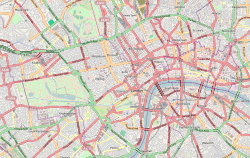St. Saviour's, Southwark
| Southwark Cathedral | |
|---|---|
| Cathedral and Collegiate Church of St Saviour and St Mary Overie | |
 |
|
| Coordinates: 51°30′22″N 0°5′23″W / 51.50611°N 0.08972°W | |
| Location |
Southwark London, SE1 |
| Country | England |
| Denomination | Church of England |
| Website | cathedral.southwark.anglican.org |
| Architecture | |
| Style | Gothic, Gothic Revival |
| Years built | 1106–1897 |
| Administration | |
| Diocese | Southwark (since 1905) |
| Province | Canterbury |
| Clergy | |
| Bishop(s) | Christopher Chessun |
| Dean | Andrew Nunn |
| Subdean | Michael Rawson, Canon Pastor |
| Precentor | Gilly Myers |
| Succentor | Vacant |
| Canon Chancellor | Mandy Ford |
| Canon Missioner | Stephen Hance |
| Canon Treasurer | Leanne Roberts |
| Honorary priest(s) | Christine Hardman |
| Curate(s) | Wendy Robins (Hon Canon and Cathedral Chaplain) |
| Laity | |
| Director of music | Peter Wright |
| Organist(s) | Stephen Disley |
| Verger | Paul Timms, Simon Gutwein, James Collins, Robert Biden, Tom Griffiths |
Southwark Cathedral (/ˈsʌðɪk/) or The Cathedral and Collegiate Church of St Saviour and St Mary Overie, Southwark, London, lies on the south bank of the River Thames close to London Bridge. It is the mother church of the Anglican Diocese of Southwark. It has been a place of Christian worship for more than 1,000 years, but a cathedral only since the creation of the diocese of Southwark in 1905.
Between 1106 and 1538 it was the church of an Augustinian priory, Southwark Priory, dedicated to the Virgin Mary. Following the dissolution of the monasteries, it became a parish church, with the new dedication of St Saviour's. The church was in the diocese of Winchester until 1877, when the parish of St Saviour's, along with other South London parishes, was transferred to the diocese of Rochester. The present building retains the basic form of the Gothic structure built between 1220 and 1420, although the nave is a late 19th-century reconstruction.
The 16th-century London historian John Stow recorded an account of the origins of the Southwark Priory of St Mary that he had heard from Bartholomew Linsted, who had been the last prior when the priory was dissolved. Linsted claimed it had been founded as a nunnery "long before the [Norman] Conquest" by a maiden named Mary, on the profits of a ferry across the Thames she had inherited from her parents. Later it was converted into a college of priests by "Swithen, a noble lady". Finally in 1106 it was refounded as an Augustinian priory.
...
Wikipedia

